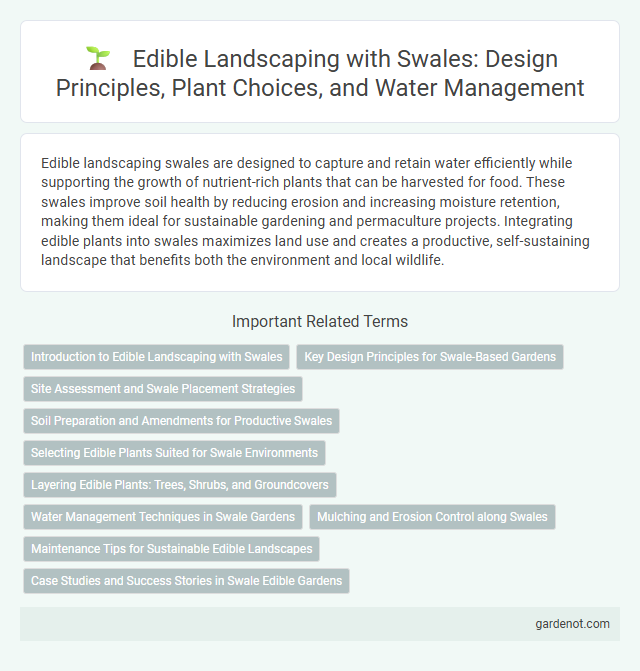Edible landscaping swales are designed to capture and retain water efficiently while supporting the growth of nutrient-rich plants that can be harvested for food. These swales improve soil health by reducing erosion and increasing moisture retention, making them ideal for sustainable gardening and permaculture projects. Integrating edible plants into swales maximizes land use and creates a productive, self-sustaining landscape that benefits both the environment and local wildlife.
Introduction to Edible Landscaping with Swales
Edible landscaping with swales integrates water-harvesting earthworks designed to capture and distribute runoff, creating fertile microclimates for diverse food crops. Swales promote soil moisture retention and nutrient cycling, enhancing the growth of fruit trees, vegetables, and herbs in sustainable garden systems. This method maximizes land productivity while conserving water and supporting biodiversity in edible landscapes.
Key Design Principles for Swale-Based Gardens
Edible landscaping swales integrate water management with food production by designing shallow, contour-following ditches that capture and infiltrate rainwater, promoting soil moisture retention for diverse plant growth. Key design principles include proper swale sizing based on watershed area, soil type, and rainfall patterns to maximize water capture and minimize erosion. Incorporating native and edible plant species tolerant to seasonal moisture variations enhances biodiversity and resilience in swale-based gardens.
Site Assessment and Swale Placement Strategies
Site assessment for edible landscaping swales involves analyzing soil type, slope gradient, and water flow patterns to ensure optimal moisture retention and nutrient distribution. Swale placement strategies prioritize contour alignment on gentle slopes to maximize rainwater infiltration and reduce erosion, enhancing plant health and yield. Integrating native, drought-tolerant edible plants along the swale edges supports ecosystem resilience and improves water efficiency.
Soil Preparation and Amendments for Productive Swales
Soil preparation for edible landscaping swales involves deep tilling and incorporating organic matter such as compost and aged manure to enhance soil fertility and structure. Amendments including biochar and rock phosphate improve nutrient retention and microbial activity, promoting robust plant growth in swale beds. Ensuring well-drained, nutrient-rich soil creates optimal conditions for productive swales that support diverse edible plants throughout the growing season.
Selecting Edible Plants Suited for Swale Environments
Selecting edible plants suited for swale environments involves prioritizing drought-tolerant and water-loving species that thrive in contour trenches with variable moisture levels. Native herbs, perennial vegetables, and fruiting shrubs like rosemary, asparagus, and elderberry adapt well to swale microclimates by efficiently utilizing captured runoff. Integrating nitrogen-fixing legumes such as lupines or clovers supports soil fertility while enhancing the productivity of edible landscaping in swale systems.
Layering Edible Plants: Trees, Shrubs, and Groundcovers
Layering edible plants in a swale involves strategically planting trees, shrubs, and groundcovers to maximize water absorption and food production. Fruit and nut trees serve as the canopy layer, while berry-producing shrubs fill the mid-layer, and nutrient-rich groundcovers protect the soil and suppress weeds. This multilayer approach enhances biodiversity, improves soil health, and creates a sustainable, productive edible landscape within the swale system.
Water Management Techniques in Swale Gardens
Edible landscaping swales integrate water management techniques by capturing and directing rainwater to enhance soil moisture and reduce erosion. These swales use strategic contouring and mulch to maximize water retention, supporting healthy growth of fruits, vegetables, and herbs. Incorporating native plants with high water absorption further optimizes water efficiency in swale gardens.
Mulching and Erosion Control along Swales
Mulching in edible landscaping swales enhances soil moisture retention and suppresses weed growth, creating optimal conditions for plant roots. Effective erosion control in swales prevents nutrient-rich topsoil loss, maintaining soil structure and promoting healthy plant development. Integrating organic mulches such as wood chips or straw stabilizes soil surfaces while enriching the ecosystem with natural decomposition.
Maintenance Tips for Sustainable Edible Landscapes
Regular mulching around plants in an edible landscaping swale conserves moisture and suppresses weeds, enhancing soil health. Pruning fruit trees and harvesting crops promptly prevent overgrowth and encourage continuous production. Monitoring swale water flow and clearing debris maintain efficient irrigation and reduce erosion, supporting long-term landscape sustainability.
Case Studies and Success Stories in Swale Edible Gardens
Swale edible gardens have demonstrated remarkable success in urban and suburban environments by effectively capturing rainwater to nourish diverse fruit and vegetable plants, improving local food security. Case studies from community projects in California reveal increased crop yields and reduced irrigation needs, showcasing sustainable water management and soil enrichment. These successes highlight the potential of swale-based edible landscaping to transform underused land into productive, resilient food systems.
Edible landscaping swale Infographic

 gardenot.com
gardenot.com